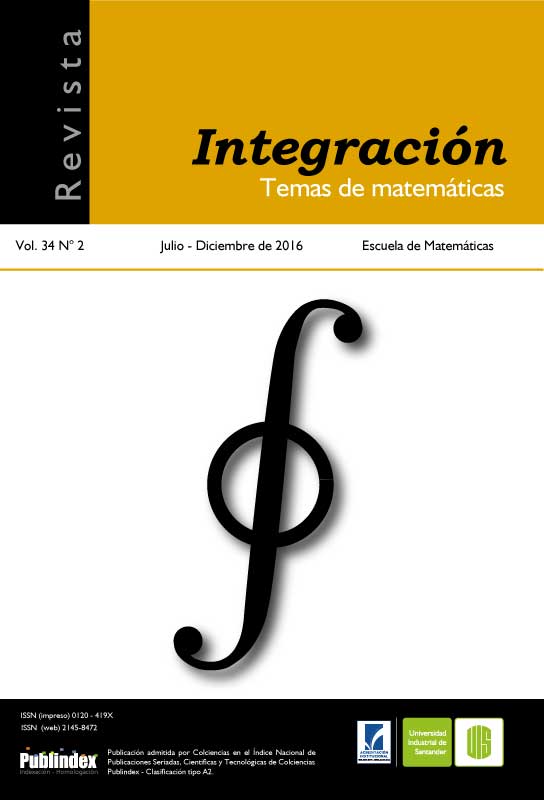Published 2016-12-12
Keywords
- Neural network,
- nonlinear complementarity problem,
- stability,
- reformulation
How to Cite
Abstract
In this paper we present a neural network model for solving the nonlinear complementarity problem. This model is derived from an equivalent unconstrained minimization reformulation of the complementarity problem, which is based on a one-parametric class of nonlinear complementarity func- tions. We establish the existence and convergence of the trajectory of the neural network, and we study its Lyapunov stability, asymptoti stabilityc as well as exponential stability. Numerical tests verify the obtained theoretical results.
To cite this article: F. Arenas, R. Pérez, H. Vivas, Un modelo de redes neuronales para complementariedad no lineal, Rev. Integr. Temas Mat. 34 (2016), No. 2, 169-185.
Downloads
References
- Arenas F., Martínez H.J. and Pérez R., "Least change secant update methods for nonlinear complementarity problem", Ingeniería y Ciencia 11 (2015), 11-36.
- Arenas F., Martínez H.J. & Pérez R., "Redefinición de la función de complementariedad de Kanzow", Revista de Ciencias 18 (2014), No. 2, 111-122.
- Arias C.A., Un algoritmo cuasi Newton global para problemas de complementariedad no lineal, Tesis de Maestría, Universidad del Cauca, 2014, 44 p.
- Billups S. C., Algorithms for complementarity problems and generalized equations, Thesis (Ph.D.), University of Wisconsin, 1995.
- Burden R.L. & Douglas Faires J., Análisis Numérico, 7ma ed., Thomson Learning, 2002.
- Chen J-S., Ko C-H. and Pan S., "A Neural network based on the generalized Fisher-Burmeister function for nonlinear complementarity problems", Information Sciences 180 (2010), No. 5, 697-711.
- Chen J-S. and Pan S., "A family of NCP functions and a descent method for the nonlinear complementarity problem", Comput. Optimi. Appl. 40 (2008), No. 3, 389-404.
- Clarke F.H., Optimization and nonsmooth analysis, John Wiley & Sons, Inc., New York, 1983.
- De Luca T., Facchinei F. and Kanzow C., "A semismooth equation approach to the solution of nonlinear complementarity problems", Math. Programming 75 (1996), No. 3, Ser. A, 407-439.
- Dennis J.E., Jr. and Schnabel R.B., Numerical methods for unconstrained optimization and nonlinear equations, Prentice Hall, Inc., Englewood Cliffs, NJ, 1983.
- Ding J. and Yin H., "A new homotopy method for solving non-linear complementarity problems", Numer. Math. J. Chi. Univ. (Engl. Ser.) 16 (2007), No. 2, 155-163.
- Ferris M.C. and Pang J.S., "Engineering and economic applications of complementarity problems", SIAM Rev. 39 (1997), No. 4, 669-713.
- Fischer A., "A special Newton-type optimization method", Optimization 24 (1992), No. 3-4, 269-284.
- Hopfield J. and Tank D.W., "Neural computation of decisions in optimization problems", Biol. Cybernet. 52 (1985), No. 3, 141-152.
- Kanzow C.J. and Kleinmichel H., "A new class of semismooth Newton-type methods for nonlinear complementarity problems", Computat. Optimi. Appl. 11 (1998), No. 3, 227-251.
- Kostreva M., "Elasto-hdrodynamic lubrication: An non-linear complementarity problem", Internat. J. Numer. Methods Fluids 4 (1984), No. 4, 377-397.
- Liao L-Z, Qi H. and Qi L., "Solving nonlinear complementarity problems with neural networks: a reformulation method approach", J. Comput. Appl. Math. 131 (2001), No. 1-2, 343-359.
- Lillo W.E., Loh M.H., Hui S. and Zak S.H., "On solving constrained optimization problems with neural networks: apenalty method approach", IEEE Trans.Neural Networks 4 (1993), No. 6, 931-940.
- Nocedal J. and Wright S.J., Numerical optimization, Second ed., Springer, New York, 2006.
- Pang J-S. and Qi L.Q., "Nonsmooth equations: motivation and algorithms", SIAM J. Optim. 3 (1993), No. 3, 443-465.
- Pérez R., Lopes V.L.R. and Martínez J.M., "On the local convergence of quasi-Newton methods for solving non linear complementarity problems", Appl. Numer. Math. 30 (1999), No. 1, 3-22.
- Qi L.Q., "Convergence analysis of some algorithms for solving nonsmooth equations", Math. Oper. Research 18 (1993), No. 1, 227-244.
- Qi L.Q. and Sun J., "A nonsmooth version of Newton method", Math. Programming, 58 (1993), No. 3, Ser. A, 353-368.
- Wardrop J.G., "Some theorical aspects of road traffic research", Proceedings of the ICE 1 (1952), No. 3, 325-362.
- Watkins D.S., Fundamentals of matrix computations, Second ed., Wiley-Interscience, New York, 2002.
- Xu Q. and Dang C., "A new homotopy method for solving non-linear complementarity problems", Optimization 57 (2008), No. 5, 681-689.
- Zabczyk J., Mathematical control theory: an introduction, Birkhäuser, Boston Inc., Boston, MA, 1992.
